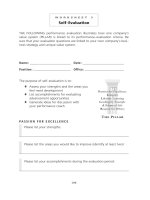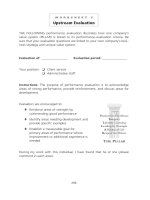Tài liệu Practice Made Perfect 18 ppt
Bạn đang xem bản rút gọn của tài liệu. Xem và tải ngay bản đầy đủ của tài liệu tại đây (139.05 KB, 10 trang )
148 PRACTICE MADE PERFECT
assets such as leasehold improvements, computers, and office furni-
ture—and in some cases, work in process and accounts receivable.
These activities consume cash. They also tend to cause the owners of
advisory firms to borrow money from a bank or to infuse their own
cash into the business, hence the term financing cash flow.
Tying the Financials Together
As you’ll see from the discussion on financial analysis in the next
chapter, the three financial statements are linked. Adding assets or
liabilities directly affects cash flow; profits or losses directly affect
the balance sheet. It’s possible to have cash and no profits, and it’s
possible to have profits and no cash. The relationship between the
two depends on whether your business is growing or shrinking and
whether you’re paying attention to the fundamentals of financial
management when you evaluate your success.
There are times when it’s acceptable to have the relationship
between profits and cash out of whack, as long as the condition is not
chronic. But in the long term, the goal should be to achieve harmony
in your financial statements. That harmony is measured by:
! A healthy balance sheet
! Strong cash flow
! Increasing profits
! Fair return to the owner
As you begin to apply discipline to the financial management
of your practice, you will also begin to see how such discipline
affects your ability to provide the ultimate client-service experience.
A growing, profitable enterprise has the financial resources to rein-
vest in the knowledge, technology, and tools that will make it easier
for clients to do business with it. Furthermore, having a financially
successful enterprise will help ensure that your focus as an adviser is
on your work and not on your own financial needs.
T
HE FINANCIAL-ADVISORY business has entered a phase of rapid
growth. For the typical firm, that growth imposes multiple
demands on the professional staff’s time, puts more pressure on fees,
and strains owner-advisers to the limit of their capacity. By observ-
ing how these factors affect your profitability, you can make better
judgments about which clients to serve, which products and services
to offer, what to charge if you have control over the fees, and who
in your organization needs coaching to become more effective and
efficient in their work. But quantifying the problem is only half the
solution. Only by seeing the trends in your financial performance
can you uncover the specific questions you need to answer.
Owners of financial-advisory practices—like those of most com-
panies—usually speak in financial terms when they describe what’s
going wrong with their business. But issues related to profitability,
cash flow, and balance-sheet strength may in fact be the symptoms
rather than the problem. Getting to the root cause involves learning
how to recognize the symptoms and what they truly indicate. Such
understanding begins with an analysis of your financial statements.
Are they organized in a way that provides insight? Are there bench-
marks that you can compare your numbers with? Are you able to
observe any trends? The process for analyzing financial statements in
a way that helps you evaluate what’s really going on in your business
isn’t mysterious. It’s logical and linear.
The process depicted in Figure 9.1 allows you to quickly assess
problems and observe patterns. By converting numbers into ratios,
149
INCOME,
PROFIT,
CASH FLOW
(and Other Dirty Words)
9.
150 PRACTICE MADE PERFECT
you can see critical relationships as they evolve and develop a plan to
improve them. By calculating the financial impact of negative vari-
ances, you can measure the magnitude of the problem. This chapter
explains a thoughtful, structured, analytical process that you can use
to perform triage on an ailing business.
Formatting the Financials
To better understand the assessment process, you’ll need to orga-
nize your firm’s financial statements in a way that makes it easier to
interpret results. At a minimum, you should have a balance sheet
and an income statement as described in chapter 8 on financial
management and outlined in worksheets 7 and 8 in the appen-
dix. Larger practices—especially those that use an accrual basis of
accounting—should also produce a statement of cash flow. For this
purpose, you’ll also want to generate financial statements for back-
to-back years, ideally three years and optimally five.
FIGURE 9.1
Financial Analysis Process
Compare the actual numbers to the budget.
Convert the numbers to relationships (ratios).
Observe the trend over a period of time.
Compare the ratios to a benchmark.
Calculate the financial impact of a negative variance.
INCOME, PROFIT, CASH FLOW (AND OTHER DIRTY WORDS) 151
Analyzing the Income Statement
The income statement is the most revealing document in a financial-
advisory practice because it helps you to quickly identify and address
potential problems. As with the balance sheet, it’s most helpful to
analyze trends in the income statement over a period of time.
Classify your revenue, expenses, and profits appropriately. This
helps you isolate the management issues such as poor productivity,
poor pricing, or poor cost control. Observing the ratios in relation-
ship to a benchmark and to a trend over several periods will help put
the problem into context. Use industry benchmarks, such as those
published by the Financial Planning Association, or other relevant
industry standards that may be published by the CFA Institute, the
Securities Industry Association (SIA), or the Risk Management
Association (RMA). Your firm’s best year or some other objective
target also makes a good benchmark or goal. Let’s look at Figure
9.2, an example of an income statement.
The income statement in Figure 9.2 indicates a practice that gen-
erates $1,000,000 in revenue. Let’s assume it has one owner; one
other financial adviser, who is an associate; and four support staff.
The salaries of the owner and financial adviser are charged to direct
expense; the support-staff salaries are considered part of overhead
expenses. In this example, $250,000 is left over in operating profit,
which the owner can choose to retain in the business, distribute as
profit sharing to the staff, or pay out to himself as a dividend. This
amount—over and above his base compensation for labor—is the
FIGURE 9.2 Income Statement
Revenue $1,000,000 100%
Direct expenses 400,000 40
Gross profit 600,000 60
Overhead expenses 350,000 35
Operating profit 250,000 25
152 PRACTICE MADE PERFECT
reward he receives in recognition of the special risks he takes as the
owner of the enterprise.
Gross Profit Margin
Measuring gross profit is a foreign concept for many advisers because
owners of advisory practices tend to pay themselves what’s left over
after all expenses are paid in the business. We refer to this as the
“book of business” syndrome, and it’s seen among practitioners who
have not yet evolved from the sales model to the entrepreneurial
model. In a solo practice, the gross profit margin is somewhat more
difficult to measure because you typically do not have other profes-
sional staff to include under direct expenses. Also, solo practitioners
can be more discretionary about what they pay themselves. But it’s
important to establish a standard of pay for professional staff, includ-
ing yourself, to help you evaluate your business success. Three good
sources for determining fair compensation are the Financial Planning
Association’s Compensation and Staffing Study, the data compiled
by the CFA Institute, and www.salary.com.
Learning how to manage gross profit margin will probably be
the single most important financial-management discipline you can
apply to your practice. When profitability is declining, most finan-
cial advisers tend to cut costs. But cutting costs will do nothing
to improve pricing or productivity or client mix. To determine the
gross profit margin, divide gross profit dollars by total revenue. For
example, if your gross profit dollars are $600,000 and your revenues
are $1,000,000, the gross profit margin would be 60 percent. Put
another way, for every dollar of revenue, you’re generating 60 cents
in gross profit.
Unfortunately, most practitioners use the financial statement as
a scorecard rather than as a management tool. But Figure 9.3 illus-
trates how you can use it to analyze profitability.
Company A is an example of a practice that has shown good
year-to-year revenue growth but declining profits. Until we recast
this adviser’s financial statements, she was not well enough in tune
with how the firm was performing as a business. Her measure of
success was the increase in gross revenue, but she had a sinking feel-
ing that she did not have much to show for it. When we examined
INCOME, PROFIT, CASH FLOW (AND OTHER DIRTY WORDS) 153
her profitability, we saw the trend illustrated in Figure 9.4.
When we showed the adviser Figure 9.4, illustrating revenue and
profit, and asked her how she would attack the problem, instinctively,
she blamed her costs. “The problem,” she said, “is that everything
I’m spending money on is essential.” We recommended that she
look more closely at her operating performance. We then showed her
FIGURE 9.3 Common Size Financial Statement
% of % of
2002 Revenue 2003 Revenue
Revenue $680,000 100% $730,000 100%
Direct expense 320,000 47 380,000 52
Gross profit 360,000 53 350,000 48
Overhead expense 265,000 39 285,000 39
Operating profit 95,000 14 65,000 9
FIGURE 9.4
Where Is the Problem?
Dollars
0
100,000
200,000
300,000
400,000
500,000
600,000
700,000
800,000
Revenue
Operating
profit
Revenue and Profit Comparison
2002 2003
$680,000
$95,000
$730,000
$65,000
Source: © Moss Adams LLP
154 PRACTICE MADE PERFECT
Figure 9.5, which shows the difference between gross profit margin
and operating profit margin.
As a percentage of revenue, her firm’s gross profit was declin-
ing. If she were able to hold this margin level, her operating margin
would stay constant as well and her operating profit dollars would
increase. She wanted to know the cause. We found the answer by
looking more carefully at how her practice had evolved during the
previous year. She had added thirty new clients, most of whom were
below her target fee amount. Because she did not believe that she
could charge them what she normally charges for a financial plan,
she had her paraplanner do the analysis at no charge to the clients.
“I was taking the long-term view,” she said. “I figured if I could get
them on the road to saving more money, I would get a better return
on investment eventually.”
Certainly, her concept had merit, but it became obvious that she
could not afford to take such a long-term view of new business with
so many new clients. If she continued to give away her services in
hopes of signing up more clients, her short-term profitability would
FIGURE 9.5
Where Is the Problem?
Percentage
Gross
profit
Operating
income
Gross Profit and Operating Profit Margin
2002 2003
0
10
20
30
40
50
60
9%
48%
14%
53%
Source: © Moss Adams LLP
INCOME, PROFIT, CASH FLOW (AND OTHER DIRTY WORDS) 155
erode to the point where she would not have the financial where-
withal to support them. One unanticipated consequence of her client-
development plan was having to hire another paraplanner to help
support the planning and implementation process. This addition to
staff raised the firm’s direct expenses even more, at a time when it
could not afford an increase.
This owner’s plight sheds light on the dangers of taking a meat-ax
to a problem that requires only a paring knife. If your gross profit
margin were declining, what would you do? Had this owner decided
to cut administrative staff (overhead), for example, she still would
not have solved the gross-profit problem, because it was caused by
poor pricing and low productivity. The key is to understand exactly
what the income statement is telling you.
For example, if the gross profit margin (gross profit divided by
revenue) is declining, the cause may be any one of five problems:
1. Poor pricing
2. Poor productivity
3. Poor payout
4. Poor client mix
5. Poor service/product mix
Examine your pricing. In today’s market, most advisers can con-
trol what their asset-management, financial-planning, and consult-
ing fees will be. They also control retainers and what they charge for
other services that are not subject to a predetermined corporate grid.
As an owner, you need to answer some key questions: Do you know
how much it costs you to deliver that service or to serve that client?
Do you view that service as a loss leader or as a way to enhance your
profitability?
Evaluate the productivity of your professional staff. Later in
this chapter, we’ll provide the key ratios to apply in analyzing the
performance of those who are developing business and advising cli-
ents. But in a nutshell, to evaluate productivity, you need to observe
trends. Current numbers tell you a lot, but a downward movement
in productivity over time sounds the alarm. Just because your gross
revenues are increasing does not mean that you are building a healthy
business. You can measure productivity by looking at increases in
156 PRACTICE MADE PERFECT
revenue per client or revenue per staff. These underlying trends are
leading indicators and can tell you if you’re heading into problems.
Consider your client mix. One great myth that has been carried
over to the financial-advisory profession is the relevance of Pareto’s
constant. Pareto was an Italian economist whose studies revealed
that 80 percent of the wealth was held by 20 percent of the popu-
lace. In the twentieth century, business managers began applying
permutations of that concept so widely to business development that
now the 80/20 rule has become an axiom in the advisory business:
ergo, 80 percent of an adviser’s business comes from 20 percent of
the clients. Strategically, acceptance of this rule does not make sense.
Why would advisers tolerate having 20 percent of their business
subsidize the activities of 80 percent of their client base—or tolerate
building a business that serves so many clients who are so far off their
“sweet spot”? Although it may be difficult to have all of your clients
fit into the optimal client profile of your business, that should still
be the goal. At a minimum, the ratio should be reversed, so that 80
percent of your clients fit within the profile. If they don’t, it’s highly
likely that the single biggest reason you’re adding overhead expense
is to support the large percentage of clients not in your sweet spot. If
you’re saying things like “I plan to add a person to serve my second-
and third-tier clients,” there’s a problem. If they’re not important
enough to be served by a first-rate client-service team, why do you
keep them as clients?
Evaluate your product and service mix. There is a knee-jerk ten-
dency to add services as a favor to a client or in reaction to a perceived
opportunity, but the service may not fit comfortably into the firm’s
existing structure or protocols as a business. Say, for example, you’re
asked to manage the 401(k) plan assets of a business-owner client.
The process of enrolling, training, and handling a bunch of little
deposits, plus the reporting, is different from the approach required
in serving a high-net-worth individual. You may be expected to
interact with the plan participants themselves. This may lead you to
divert valuable resources by assigning a staff member to deal with this
“one-off” service. You may justify providing this service as an added
value to a big client, but how many of these exceptions do you have?
And how do they affect the way your staff works or the way you man-
INCOME, PROFIT, CASH FLOW (AND OTHER DIRTY WORDS) 157
age quality control? Viewing your business model through the prism
of revenue—and incremental revenue at that—may be harming your
practice. In situations like this, employ your business strategy as your
decision-making tool to ensure that the firm’s product and service
mix is being developed in line with the overall strategy you’ve com-
mitted to, rather than in a haphazard, opportunistic way (see chapter
2 on developing a long-term view).
Examine your compensation practices. Are they aligned with
your business strategy? Are they suited to your market? Are you get-
ting an adequate return on this investment? Is your professional staff
contributing enough to the success of your enterprise to justify their
compensation? Does your incentive plan encourage behavior that
works for your business and for your clients?
Some fundamental steps are essential (see also “Productivity
Analysis,” page 171). Evaluate each professional staff member, or
each team, to determine whether their contributions are consistent
with those of other staff members or with whatever benchmark
you’re using. For those whose performance is below par, get them
help to improve their skills or get them out. Evaluate your relation-
ship with clients, too. Can you afford to keep all of them, or are some
not netting enough revenue to cover the effort you put into manag-
ing the relationship?
Do you know what the value of your time is? Or the value of your
staff’s time? Are you getting paid adequately for that time? Raising
prices for such things as managing or supervising assets, developing
financial or estate plans, or hourly consulting is always a challenge,
but especially in a tepid or mixed market. Raising prices can also
have a dampening effect on increasing revenue volume. But if doing
so will force you to be more selective about which clients you take,
it could be a good thing. Is there anything wrong with working less
and making more? Chances are you have not touched your pricing,
especially for planning and consulting services, in a very long time.
When you use gross profit margin as a management tool, many
improvements can result. Overhead costs are manageable. That’s
obvious. The silent killer is the deterioration of pricing, productivity,
service mix, and client mix when you’re not even aware that you’re
headed for trouble. It’s a bit like developing high blood pressure: you









